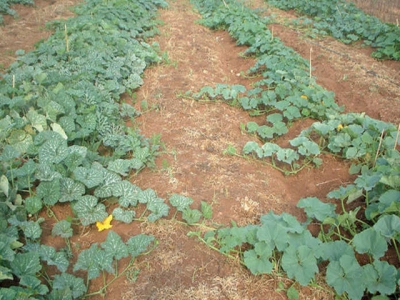Fertilising cucurbits for crop success

You don’t fertilise cucurbits solely according to the plant’s requirements – you also have to take into account the soil’s fertility.
You can consider band fertilisation for curcubits where rows are far apart.
Many farmers reckon all you need to do is apply the amount of fertiliser the plant will extract based on its special requirements. This belief isn’t as common as it used to be, but it’s still fairly widespread. The truth is, you can tweak the fertiliser slightly to suit certain crops, but most plants will do equally well in soil which is in a balanced, fertile state. Differences emerge when it comes to post-planting applications of top-dressings, which will be different for different crops.
A soil analysis, then, is essential to determine what’s in the soil and what’s required in order to get the fertiliser elements into balance with one another. Certain elements, for example, are taken up by the crop in the proportion that they are available in the soil even when each may be sufficient in the required quantity. In this case, the plant can’t select each element as required just as you can’t take sugar out of your tea if there’s too much. If there is an imbalance, your fertiliser representatives will tell you what is needed to get the balance right for most plants.
Fertilise properly
The cost of cultivation, seed and irrigation will be the same whether you fertilise properly or not. By not fertilising properly, however, you will have a much lower yield for the same fixed costs. What’s more, the benefits will carry over to subsequent crops. This said, there are ways of reducing fertiliser costs in some cases. Pumpkins, and especially those varieties with long runners, may be planted in 5m rows, and you can apply the fertiliser in a band along these rows.
This isn’t ideal, as it creates uneven fertility in the land which will reflect in subsequent crops. But it’s worth considering if you’re planting on leased ground and don’t want to go to great expenditure to improve someone else’s ground for subsequent crops.It can also be considered where you simply can’t afford to fertilise the whole land to it’s full potential – but as a temporary measure only.
If the soil is acidic, it’s possible a molybdenum deficiency will develop later on (and cucurbits are more sensitive to this than most crops). To avoid this (or to be on the safe side), soak the seeds in 5l water to which 15g of sodium molybdate has been added.
Boron and Nitrogen
Another element which can be added as a matter of course is boron. This can be applied once or twice on the foliage at a rate of 1kg SoluBor per hectare. The costs are minimal, but the benefits can be great – and even if it wasn’t actually necessary, the extra boron will do no harm at this rate. Post planting nitrogen side-dressings are more tricky because, usually, you rely on your experience and knowledge of the symptoms of nitrogen deficiency to determine the amount and frequency of applications. Apply too much nitrogen to pumpkins, gems and squashes, and you can cause the area to close up before sufficient fruit have formed.
Soil with a healthy organic content may require no additional nitrogen, while sandy soil will require more. Usually, an application a few weeks after emergence is needed and then you must observe the size and colour of leaves and the plant’s vigour to determine when and how much more to apply. This is where experience comes into play, but if you understand the principles beforehand, you will learn faster.
Related news
 Biological Control of Common Greenhouse Pests - Part 2
Biological Control of Common Greenhouse Pests - Part 2 You can order these controls through the post, and they come in a form which is easy to distribute around the greenhouse
 Pests and Diseases of Tree Fruit - Part 2
Pests and Diseases of Tree Fruit - Part 2 Typical symptoms: Red blisters appear on leaves in early summer; infected leaves turn brown and fall prematurely.
 Planting Preparations for Growing Tomatoes
Planting Preparations for Growing Tomatoes No chances should be taken with border soil. It is advisable to have some form of analysis carried out, even if it is only a pH and potato cyst eelworm check.